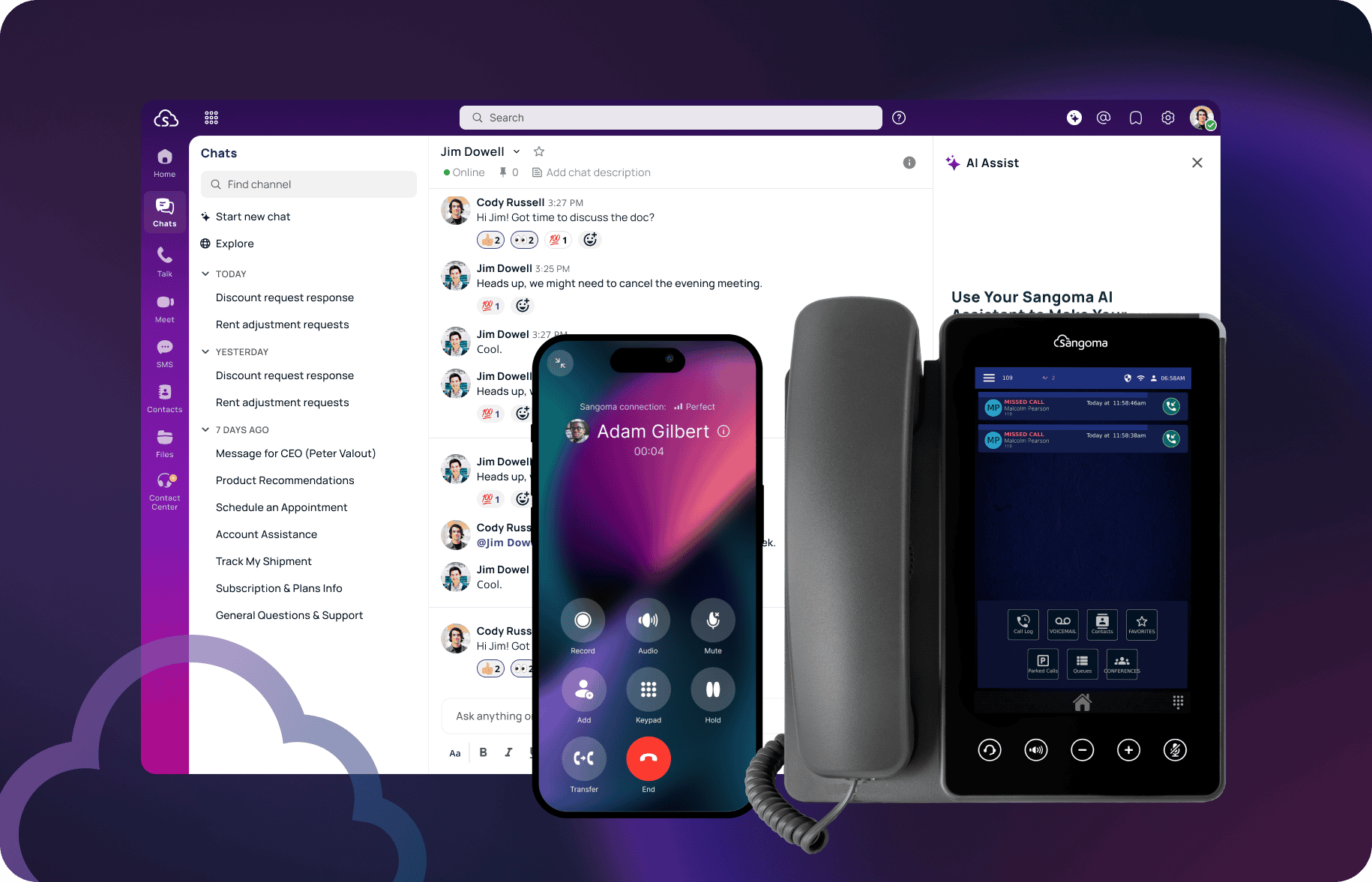Why Hybrid UC is the Best of Both Worlds for Scalability and Control

Unified Communications (UC) usually pushes businesses towards a tough choice: the robust control and security of on-premises systems, or the agility and scalability provided by cloud-based solutions. How about if you didn’t have to choose? Hybrid unified communications delivers precise control over critical infrastructure while harnessing cloud flexibility to scale effortlessly.
In this article, we’ll explore why hybrid UC truly offers the best of both worlds, empowering businesses to achieve seamless growth without sacrificing control.
Key Takeaways
- Hybrid UC gives you the scalability of cloud and the control of on-prem, without forcing a tradeoff.
- It’s ideal for businesses that need to secure sensitive data while still supporting growth and remote work.
- The right setup starts with assessing your real communication needs, not just buying more tech.
- Strong network planning and built-in failover are essential for day-one performance and long-term reliability.
- Security, compliance, and user training need to be part of the plan, not afterthoughts.
- Ongoing monitoring and responsive support are what keep hybrid UC efficient after launch.
- With careful planning, hybrid UC becomes a long-term asset, not just a patchwork solution.
What is Hybrid Unified Communications?
Hybrid Unified Communications (UC) combines the best of on-premises and cloud-based communication solutions (UCaaS) into a single, powerful system. Instead of choosing between full on-site control or the flexibility of cloud, hybrid UC gives you both. You keep essential infrastructure on-site—great for compliance and control—while tapping into the scalability of the cloud when you need it.
But it’s not just about convenience. Hybrid UC also gives you a safety net. Sangoma’s hybrid platforms come with built-in business continuity features like local survivability and automatic failover. If the internet drops or a service goes down, internal calls still go through and your team stays connected. That kind of reliability matters—especially when communication downtime means lost revenue or missed opportunities.
Businesses that adopt hybrid UC get the control they need, the flexibility they want, and the uptime they can count on.
Explore how Sangoma’s Hybrid UC solutions help businesses achieve both scalability and control.
Main Components of Hybrid Unified Communications
Hybrid UC connects your existing local devices—like business phones, intercoms, or paging systems—to cloud-based tools such as voice, messaging, and video conferencing. It delivers everything through a unified interface, so IT teams can manage both on-site and remote communications from one platform.
Combining all these components create a flexible, scalable, and secure communication system that escalates the growth of your business.
Benefits of a Hybrid UC System: The Best of Both Worlds
Hybrid Unified Communications is uniquely designed to provide businesses the consolidated strengths of on-premises and cloud solutions—delivering scalability, control, reliability, and flexibility without compromises.
Scalability and Flexibility
Hybrid UC grows alongside your business. Whether you’re adding new offices, expanding your workforce, or supporting remote teams, a hybrid approach ensures your communications infrastructure adapts quickly. Cloud services add flexibility, enabling rapid deployment of new tools, features, and user capabilities as your business evolves.
Better Control & Security
Hybrid UC gives your business tighter control over sensitive communications and critical data. With core infrastructure on-site, you get full visibility into how data is handled—while built-in security features like end-to-end encryption, strong authentication, and compliance tools help keep everything protected.
It also supports local Quality of Service (QoS) for voice traffic, prioritizing phone calls on the network to avoid jitter, lag, and dropouts. That means clearer conversations and fewer disruptions, even during peak usage.
Business Continuity & Disaster Recovery
Downtime isn’t affordable for modern businesses. Hybrid UC safeguards operations through built-in redundancy, on-site survivability, and multiple failover mechanisms like 4G LTE and POTS lines. If the cloud system faces disruptions, your on-site system will automatically take over, maintaining communication continuity and ensuring your business remains operational even during unexpected outages or disasters.
Deployment Flexibility and Interoperability
Adopting a Hybrid UC model allows you to create a communication network that automatically adapts during disruptions. In the event of an issue, your systems switch between cloud and on-prem, keeping your business operations intact. This approach eliminates the need to choose between the two, offering a reliable solution that supports your goals and ensures uninterrupted communication.
When is a Hybrid Communications System a Right Choice?
Hybrid UC is a smart fit if your business needs:
- Flexibility and control over sensitive data
If you’re in healthcare, finance, or government, keeping critical data on-site gives you tighter control—while still using the cloud to scale fast when needed. - Support for distributed teams
If you have multiple offices or remote teams, hybrid UC lets everyone communicate smoothly while giving your IT team centralized control and management. - Strict data residency or compliance requirements
Some data just can’t leave the building. Hybrid UC lets you keep those workflows local, and use the cloud for everything else. - Reliable voice communication for mission-critical environments
Hybrid UC includes site survivability and automatic failover options, so internal calls keep working even during internet outages—avoiding disruptions when uptime matters most. - Room to grow without overhauling infrastructure
Scale on your terms. Add cloud tools as you go while keeping your local systems running without disruption.
Hybrid vs. Cloud vs. On-Premises UC
Choosing between hybrid, cloud (UCaaS), and on-premises UC comes down to your business priorities. On-premises UC gives you maximum control and security but lacks flexibility and easy scalability. Cloud UC, on the other hand, offers simplicity and quick scalability but may compromise on customization and control.
Hybrid UC strikes the right balance—giving you precise control over sensitive data with on-site hardware, while also using cloud services to scale quickly and stay agile.
Here’s a quick comparison:
| Feature | Hybrid UC | Cloud UC (UCaaS) | On-Premises UC |
| Scalability | High | Very High | Limited |
| Control & Security | High | Moderate | Very High |
| Deployment Speed | Fast | Fastest | Slow |
| Customization | High | Moderate-Low | Very High |
| Management Complexity | Moderate | Low | High |
| Cost Structure | Balanced (CapEx + OpEx) | Predictable (OpEx) | High upfront (CapEx) |
| Business Continuity | Excellent (Built-in redundancy) | Good | Depends on internal redundancy |
For an in-depth look at choosing the best UC model for your business, check out our Ultimate Guide to Unified Communications.
Best Practices for Implementing a Hybrid UC System
Implementing a hybrid UC system can transform your business communications—but careful planning ensures success. Follow these best practices to get it right:
1. Start with a Real Needs Assessment—Not Assumptions
Before touching technology, step back and audit your communication landscape. Look for:
- Gaps in current workflows (e.g., frequent dropped calls, scattered tools, missed messages).
- Workforce structure: Are your teams in-office, remote, or hybrid? Are they switching devices all day?
- Compliance demands (especially if you’re in healthcare, education, or finance).
- Legacy infrastructure: What do you need to keep? What’s holding you back?
Pro Tip: Bring IT and department heads together early. You’ll catch requirements most top-down plans miss.
2. Choose a UC Partner That Offers More Than Just “Flexibility”
Your hybrid UC platform has to do more than just check a box. Look for:
- Built-in failover options like 4G LTE backup or local survivability (Sangoma’s StarBox® handles this well).
- Support for mobile and remote workers—including apps that actually sync across devices.
- Integration-ready architecture: CRMs like Salesforce, Microsoft Teams, and custom workflows shouldn’t need a workaround.
- Transparent, single-vendor support—no finger-pointing when something breaks.
- Ridiculous reliability: Look for at least 99% uptime, but the more nines, the better—aim for 99.999% uptime to ensure your communication systems are always available.
Red Flag: If a vendor can’t clearly explain how voice, video, chat, and file sharing work together, move on.
Also see: Comparing UCaaS Providers
3. Get Your Network Hybrid-Ready
Hybrid UC lives or dies by your infrastructure. Here’s what to check:
- Bandwidth: Make sure you have headroom, especially for concurrent video and VoIP traffic.
- QoS (Quality of Service): Prioritize voice traffic. This isn’t optional—poor call quality kills productivity.
- Hardware compatibility: Confirm that your phones, routers, and firewalls can handle SIP traffic and cloud signaling.
- Multiple internet paths/failover: LTE or secondary WAN lines keep you running even when your ISP stumbles.
Smart Add-on: Consider Sangoma’s Managed Network and SD-WAN to guarantee uptime and better VoIP performance.
4. Security and Compliance
Don’t bolt on security later. If your hybrid UC setup handles sensitive data—think healthcare records or financial transactions—you need to lock it down from the start.
Here’s what to prioritize:
- End-to-end encryption for voice, video, chat, and file sharing—at rest and in transit.
- Role-based access controls (RBAC): Limit access based on roles, not just credentials. No more “everyone is an admin” situations.
- Secure mobile clients: Make sure your mobile apps enforce the same policies as desktops—PIN lock, remote wipe, and encrypted storage.
- HIPAA, PCI-DSS readiness: Your platform should make compliance easy—not something you duct tape together later.
- Audit logs and real-time monitoring: Track who accessed what, when, and from where. Alerts should flag anything unusual.
- Failover security continuity: Even during outages, your backup systems (like LTE or on-prem failover) should maintain encryption and call controls.
5. Staff Training and User Adoption
A great UC system still fails if no one knows how to use it. Employee buy-in accelerates productivity gains and smooths your transition.
Plan for:
- End-user onboarding with real use cases—how to start a video meeting from chat, how to transfer calls on mobile, etc.
- Admin training for monitoring uptime, adjusting call flows, and managing permissions.
- Ongoing support access—make sure your teams know where to go when they hit a wall.
Tip: Use Sangoma’s 24/7 support and TeamHub’s built-in AI assistant (@ASKSangoma) to reduce help desk tickets and onboard faster.
6. Monitor, Measure, Optimize
Your UC system should grow with your business. Once you’re live:
- Review call analytics regularly to spot bottlenecks or service gaps.
- Audit device usage—see which tools are helping and which ones are gathering dust.
- Refine call routing and IVRs based on customer feedback and agent input.
- Test your failover plan quarterly. Don’t wait until the real outage.
If you’re using Sangoma’s hybrid UCaaS, you can scale features up or down without ripping out hardware. That agility is key for growing teams.
7. Choose Support That’s Actually Supportive
Finally, don’t underestimate the value of solid technical support. Choose a vendor that offers responsive assistance, proactive troubleshooting, and ongoing maintenance.
Here’s what to look for in a support partner:
- Live assistance—not just chatbots or ticket queues with 2-day replies.
- Proactive monitoring and alerts: Issues should be flagged before your users notice them.
- Expert onboarding and migration help: Especially if you’re coming from a mix of legacy systems.
- Clear documentation and training resources: Your IT team shouldn’t need to guess.
- Long-term maintenance plans: Updates, patching, hardware compatibility checks—all handled.
Why Sangoma? You get real-time help from people who built the system—not a third-party call center. Our in-house support team is available around the clock, and you get a single point of contact for everything—from your phones to your failover.
Industries That Can Benefit from Hybrid Unified Communications System
Hybrid UC solutions are versatile and ideal for several industries, especially where balancing control and scalability is crucial. Here’s how different industries benefit:
Healthcare
Hospitals and clinics rely on secure communication and compliance with strict regulations like HIPAA. Hybrid UC allows healthcare providers to securely handle patient information on-site while leveraging cloud flexibility for telehealth and remote collaboration.
Explore our Healthcare UC Solutions
Retail
Retail businesses with multiple stores or online operations require streamlined communication. Hybrid UC connects locations easily, supports quick scalability during peak seasons, and secures sensitive customer data and transactions.
Education
Educational institutions benefit from hybrid UC through enhanced collaboration between campuses, remote learning flexibility, and centralized control over sensitive student information. It simplifies administration and keeps communications reliable.
Explore Education UC Solutions
Manufacturing
Manufacturers often manage multiple sites with critical on-premises systems. Hybrid UC helps by improving real-time communication between factories, warehouses, and offices, while maintaining tight security around proprietary data.
Explore Manufacturing Solutions
Hospitality
Hotels and hospitality businesses require reliable, scalable communication tools. Hybrid UC allows centralized management of guest services, supports rapid growth during peak seasons, and ensures consistent, high-quality guest experiences across locations.
Is Hybrid UC Right for Your Business? Find Out Now!
Hybrid UC offers the ideal blend of scalability, control, flexibility, and security—perfectly suited to the evolving needs of modern businesses. If you’re looking for a communications solution that grows easily, protects sensitive data, and quickly adapts to changing demands, hybrid UC might be your answer.
Consider your organization’s unique needs: Do you require strong security and compliance, rapid scalability, or easy management across multiple locations? If yes, Sangoma’s hybrid UC solutions can deliver exactly that, tailored specifically for your business.
Get in touch with Sangoma today and find out how hybrid UC can transform your communications strategy.




